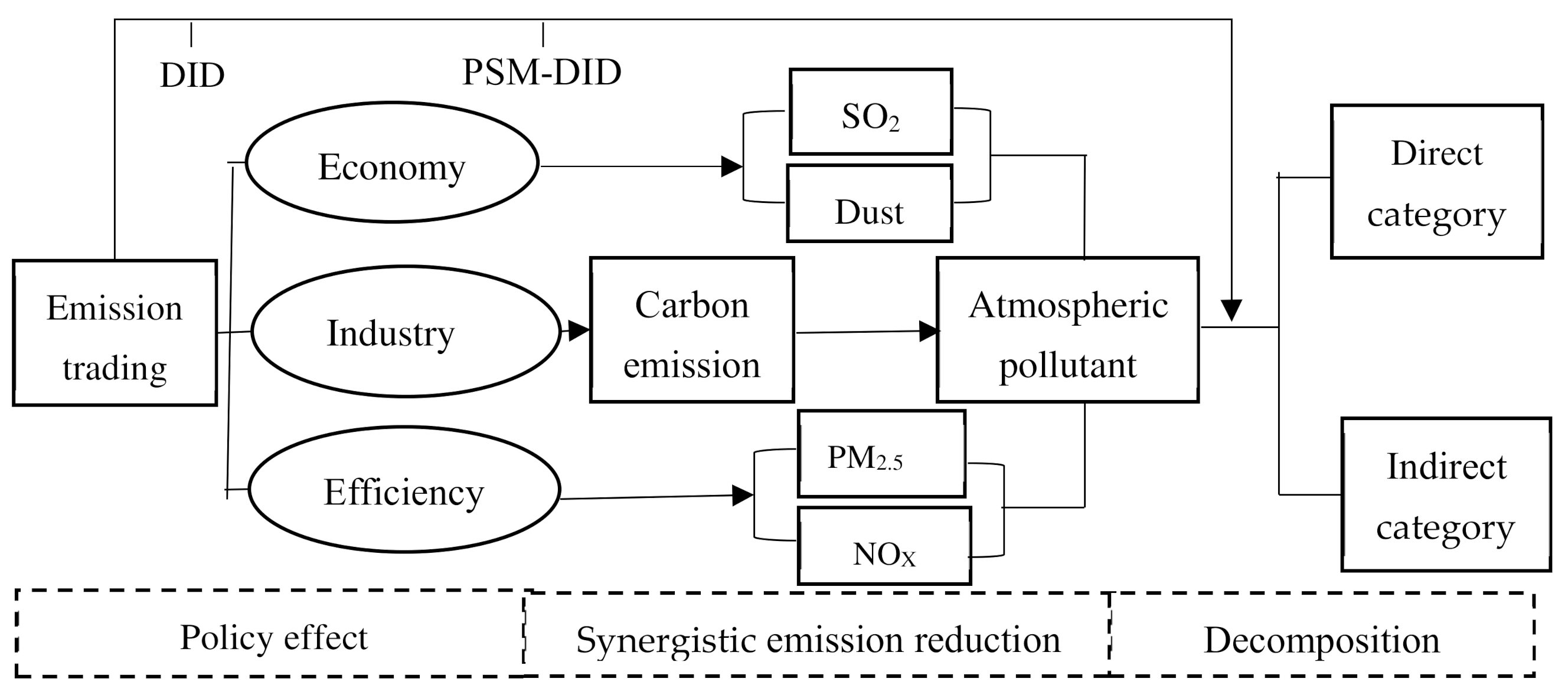The externality cost of carbon emission can be internalized through emission trading schemes (ETSs), which contribute to carbon emission reduction. Consequently, ETSs have been widely adopted in the implementation of emission reduction targets.
- emission trading scheme
- CO2
- atmospheric pollutant
- synergistic effect
- IPAT-LMDI
1. Introduction
As the country producing the most carbon emissions, China promised a 60–65% reduction in carbon dioxide emissions per unit gross domestic product (GDP) by 2030 compared with 2005 at the Copenhagen Climate Change Conference. To achieve these emission reduction goals, China actively launched the ETS pilot program, which lasted for 3 years, from 2013 to 2015, consisting of Beijing, Tianjin, Shanghai, Guangdong, Hubei, Chongqing and Shenzhen. Then, the ETS was promoted widely, and the nationwide carbon trading market was gradually established by 2017.
Recently, a synergistic control method driven by carbon emission reduction has gradually attracted much attention. For example, the 13th Five-Year Plan of Work on Controlling Greenhouse Gas Emissions emphasized that synergistic control of carbon dioxide (CO2) and atmospheric pollutants is the key path for green transformation. With the increasingly stringent emission reduction goals, synergistic governance avoids excessive time costs and contributes to more socioeconomic welfare, resulting in the virtuous circle of environmental quality optimization. Moreover, CO2 and atmospheric pollutants are characterized as homologous as they are formed from the burning of fossil fuels and concentrated in highly energy-consuming sectors. Within the expansion mechanism of production activities, the carbon emission reduction strategy can reduce atmospheric pollutants simultaneously.
Though the ETS in China has been fully advanced, the carbon trading market has not been fully explored in research. Few studies focus on the synergistic control of CO2 and atmospheric pollutants. To investigate whether ETS can drive the synergistic emission reduction effect between CO2 and atmospheric pollutants, decomposition analysis was conducted in this study with the combination method of IPAT and logarithmic mean Divisia index (IPAT-LMDI) model, and quantitative analysis (as shown in Figure 1) was further undertaken. Moreover, difference-in-differences (DID) and propensity score matching difference-in-differences (PSM-DID) methods were used to verify the synergistic emission reduction effect of ETS pilots in China, covering the selected period from 2007 to 2016.

Figure 1. The framework of synergistic analysis, decomposition and policy evaluation.
2. Policy Implications
- (1)Atmospheric pollutants emission reduction synergistically responds to carbon emission reduction, among which, the SO
- and Dust are affected significantly, while the NO
- and PM
- are less affected. Further, ETS reliably reduces CO
- and SO
- , but fails to drive the emission reduction of NO
- , Dust and PM
- . Therefore, the synergistic emission reduction effect of CO
- and atmospheric pollutants mainly manifests as CO
- and SO
- .
- (2)Compared with the indirect synergy, the direct synergy accounts for higher proportion of overall synergistic emission reduction effect. Moreover, ETS promotes the direct synergy of SO
- and CO
- significantly, but rarely affects their indirect synergy. The synergistic emission reduction effect driven by ETS mostly performs as continual increase in direct synergy.
- (3)Energy efficiency and industrial structure are the potential channels that achieve synergistic emission reduction effect driven by ETS. Conversely, economic development increases CO
- emission to a certain extent, owing to the expansion of scale effect. With the combination of multiple channels, the synergistic emission reduction effect driven by ETS is strengthened obviously.
We highlights specific recommendations that may optimize China’s national emission trading scheme and promote synergistic emission reduction.
First, the government should emphasize the coordinated management of CO2 and atmospheric pollutants, through integrating high-carbon industries into comprehensive emission reduction system and innovating synergistic technology applied in environmental management. Given the current state of synergistic emission reduction, to avoid the dilemma of broken treatment, introducing environmental policies to strengthen the coordination of regional environmental protection work.
Second, national carbon trading market need to promoted vigorously and ETS should be continually improved. For example, the assessment criterion is no longer confined to carbon emission reduction, while also covers atmospheric pollutants emission reduction.
Finally, to improve carbon trading policy, improving energy efficiency and optimizing industry structure should be taken into account. On the one hand, the government should actively promote low-carbon technological innovation of enterprises, but also pay attention to avoid the excessive carbon emission caused by economic expansion. On the other hand, the government needs to promote the transformation of high-carbon industries, investment of green-oriented technology and improvement of energy efficiency within the framework of synergistic emission reduction.
